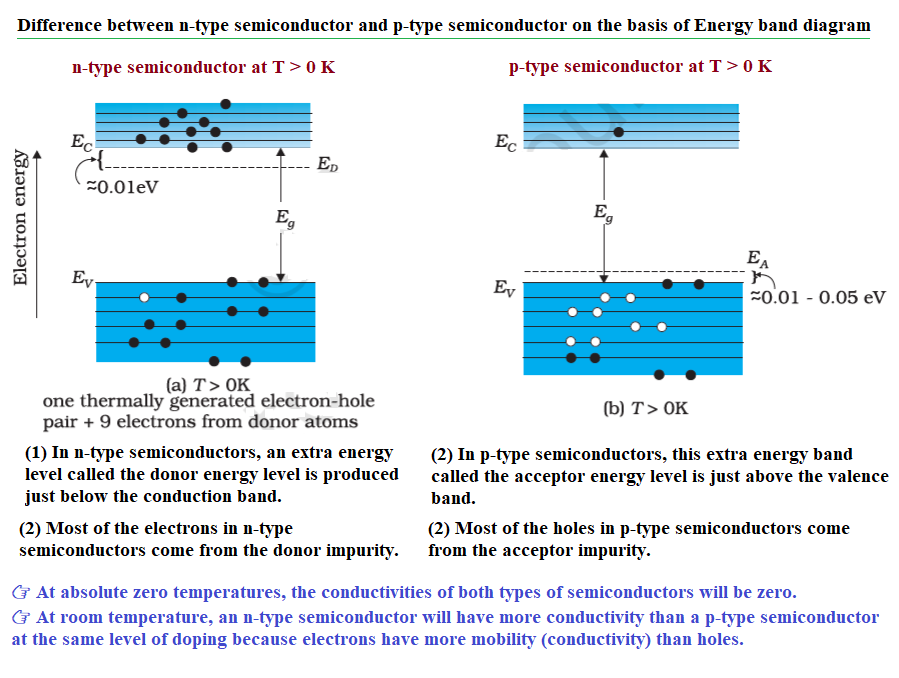Hello, readers! Here you can learn about n-type semiconductor. A pure semiconductor doped with a pentavalent impurity like As, Sb, P etc. gives an n-type semiconductor.
Table of Contents
n-type semiconductor
A pure semiconductor doped with a pentavalent impurity gives an n-type semiconductor. When a dopant atom of a +5 valency (pentavalent donor atom like As, Sb, P, etc.) occupies the position of an atom in the crystal lattice of Si, four of its electrons are bonded with the four neighbouring silicon atoms, while the fifth electron remains very weakly bound to its parent atom. Since impurity atoms donate one free electron to the conduction band of a semiconductor, this dopant atom is called a donor atom.

The donor level is the energy level occupied by a donated electron in the dopant atom (ED = 0.01eV for Si), and thus a very small ionization energy is required to make this electron free, and even at room temperature (thermal energy of 0.03eV), it will be free to move in the semiconductor lattice and show conductivity.

In an n-type semiconductor,
- Total electron count (ne) = electrons contributed by the donor atom + electrons generated by thermal excitation from an intrinsic source.
- Total number of holes (nh) = holes produced solely by thermal excitation of electrons from an intrinsic source.
- The number of electrons is much more than the number of holes in n-type semiconductor.
Difference between n-type semiconductor and p-type semiconductor on the basis of Energy band diagram

Important questions from Topic
What types of dopants are commonly used in semiconductor materials, and how do they affect the material’s properties?
Common dopants used in semiconductor materials include boron, phosphorus, arsenic, and antimony belongs to 13th and 15th group elements of periodic table. These dopants can donate or accept electrons, which affects the material’s electrical conductivity, and they can also modify its optical and thermal properties.
How does the doping concentration of a semiconductor material affect its electrical conductivity?
The doping concentration of a semiconductor material can significantly affect its electrical conductivity. Higher doping concentrations generally lead to higher conductivity, since more charge carriers are present in the material.
What is the difference between n-type and p-type doping, and how are they achieved in practice?
N-type and p-type doping refer to the introduction of electrons or holes, respectively, into a semiconductor material. This is achieved by adding dopants that donate or accept electrons, such as phosphorus for n-type doping or boron for p-type doping.
What is an n-type semiconductor?
Ans: An n-type semiconductor is a type of semiconductor material in which the majority charge carriers are electrons, which are negatively charged particles that occupy the conduction band of the material. These are created by doping an intrinsic or lightly doped semiconductor material with impurities that have one more valence electron than the host material.
What are some common impurities used for doping n-type semiconductors?
Ans: Phosphorus, arsenic, and antimony are commonly used impurities for doping n-type semiconductors. These elements have five valence electrons, and when they are incorporated into a semiconductor lattice, they create excess electrons in the conduction band that act as the majority carriers.
How does doping affect the electronic properties of a semiconductor?
Ans: Doping introduces impurity atoms into a semiconductor lattice, which can either donate or accept electrons to change the conductivity and electronic properties of the material. N-type doping creates a material with a net negative charge and an excess of electrons in the conduction band, making it a negative-type conductor.
What are some practical applications of n-type semiconductors?
Ans: These are used in a wide variety of electronic devices, including diodes, transistors, and solar cells. They are often used in conjunction with p-type semiconductors to form p-n junctions, which have unique electronic properties that are useful for a range of applications.
How does an n-type semiconductor differ from a p-type semiconductor?
Ans: A p-type semiconductor is doped with impurities that have one less valence electron than the host material, creating excess holes in the valence band that act as the majority carriers. In contrast, an n-type semiconductor is doped with impurities that have one more valence electron than the host material, creating excess electrons in the conduction band that act as the majority carriers. When an n-type and p-type semiconductor are brought into contact, they form a p-n junction with unique electronic properties.
How is the conductivity of an n-type semiconductor affected by temperature?
Ans: Like all semiconductors, the conductivity of an n-type semiconductor increases with temperature due to increased thermal energy that promotes the formation of additional charge carriers. However, the temperature dependence of the conductivity is more complex than for metals or insulators, as it depends on both the intrinsic properties of the material and the effects of doping.
What is a p-type semiconductor?
Ans: A p-type semiconductor is a type of semiconductor material in which the majority charge carriers are holes, which are positively charged vacancies in the valence band of the material. P-type semiconductors are created by doping an intrinsic or lightly doped semiconductor material with impurities that have one less valence electron than the host material.
What are some common impurities used for doping p-type semiconductors?
Ans: Boron, aluminum, and gallium are commonly used impurities for doping p-type semiconductors. These elements have only three valence electrons, and when they are incorporated into a semiconductor lattice, they create holes in the valence band that act as the majority carriers.
MY YouTube Channel Link : 👉🖱 https://www.youtube.com/channel/UCGpC7nWE0-bBv9I53MM8qjQ